Course Appetizer Serving temperature Room temperature, cold | ||
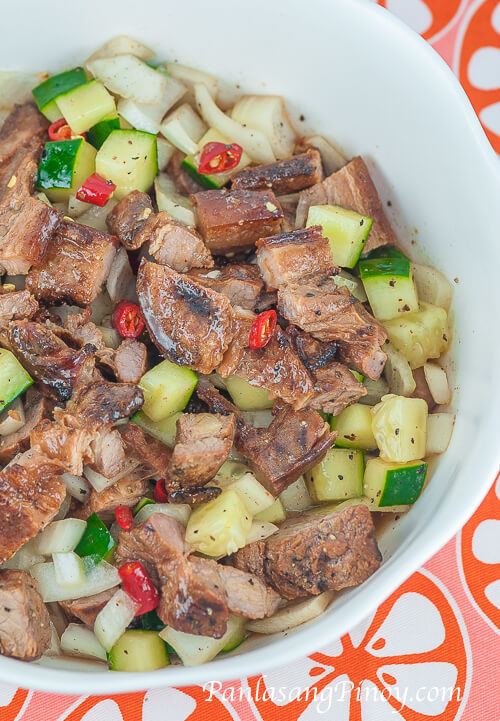 | ||
Main ingredients Variations Kilawen, Kilayen, Lawal, Biyaring, Kulao Similar Kaldereta, Pinakbet, Sisig, Paksiw, Ginataan | ||
Kinilaw (literally "eaten raw") is a raw seafood dish native to the Philippines, similar to ceviche. It is more accurately a cooking process that relies on vinegar to denature the ingredients, rather than a dish, as it can also be used to prepare meat and vegetables. Meat-based kinilaw (usually known as kilawin) are more common in the northern Philippines and use blanched and lightly grilled meat (not raw). Kinilaw dishes are usually eaten as appetizers before a meal, or as finger food (pulutan) with alcoholic drinks.
Contents
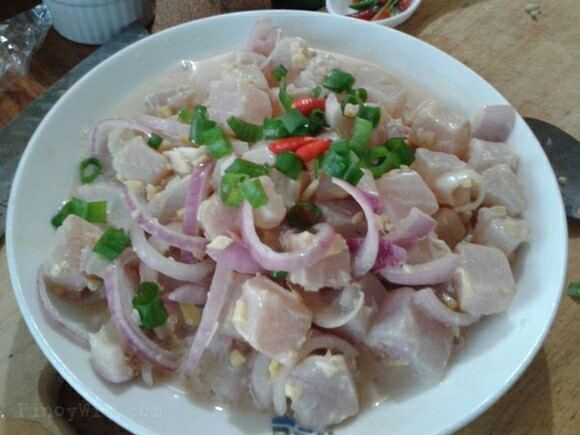
Description
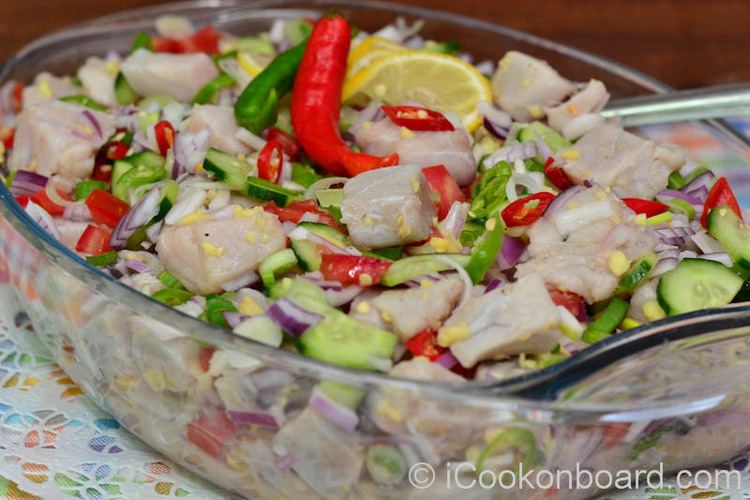
The most common kinilaw dish is kinilaw na isda ("fish kinilaw") prepared using raw cubed fish mixed with vinegar (usually coconut vinegar or cane vinegar) as the primary denaturing agent; along with a souring agent to enhance the tartness like calamansi, dayap, biasong, kamias, tamarind, green mangoes, balimbing, and green sineguelas. It is flavored with salt and spices like black pepper, ginger, onions, and chili peppers (commonly siling labuyo or bird's eye chili).
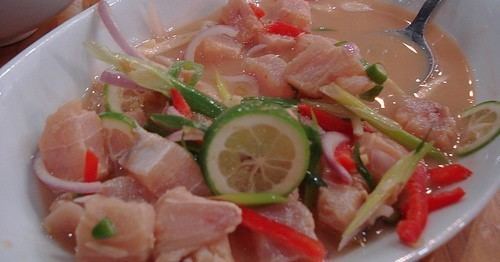
To neutralize the fishy taste and the acidity before serving, juice extracts from the grated flesh of tabon-tabon fruits (Atuna racemosa), dungon fruits (Heritiera sylvatica and Heritiera littoralis), or immature small young coconuts are also commonly added. Extracts from the bark scrapings of sineguelas or bakawan trees (Rhizophora mangroves) are also used similarly. Some regional variants also add gatâ (coconut milk), sugar, or even soft drinks to reduce the sourness.
Popular kinds of fish used in kinilaw include tanigue or tangigue (Spanish mackerels, king mackerel, or wahoo), malasugi (marlins or swordfish), tambakol (yellowfin tuna), bangus (milkfish), and anchovies.
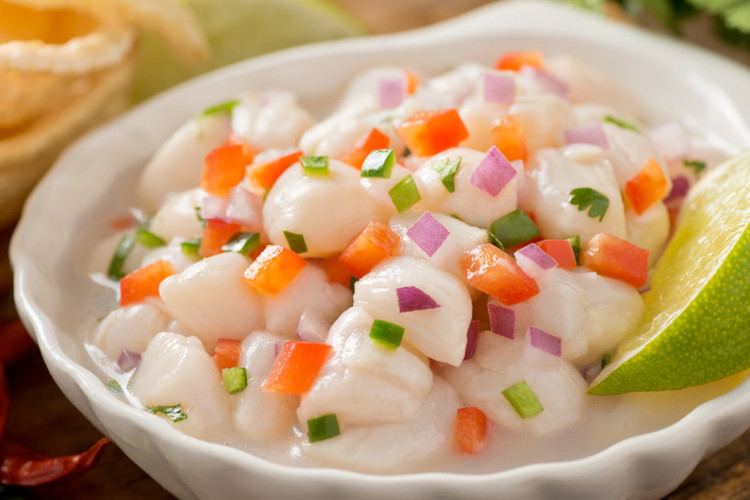
Variants predominantly from the northern Philippines use meat (usually called kilawin to distinguish them from other kinilaw), including goat meat, beef, carabao, pork, and chicken. Unlike fish kinilaw, meat kilawin are not eaten raw but are cooked by boiling or grilling or both. They are usually done rare to medium rare, though in some cases the meat are fully cooked. Meat-based kilawin are also traditionally eaten with papaít (literally "bittering agent"), usually the bile extracted from the gall bladder or by squishing the chewed grass in an animal's stomach.
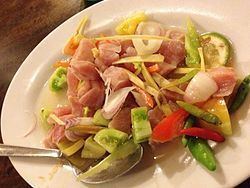
Ingredients used in seafood and meat kinilaw must be fresh and properly cleaned, as there are health hazards involved with consuming raw seafood and partly cooked meat.
Other ingredients used in kinilaw include shrimp, squid, clams, oysters, crabs, sea urchin roe, seaweed, jellyfish, shipworms (tamilok) or even beetle larvae (grubs), among others. They vary in terms of preparation, depending on the ingredients, from raw to fully cooked. For example, shrimp are prepared raw, while squid needs to be blanched first to tenderize the flesh.
Kinilaw also refers to dishes using raw fruits and vegetables marinated in vinegar and spices. Examples include cucumbers (pepino), bitter melons (ampalaya), young sweet potato (camote) leaves, young papaya, vegetable ferns (pako), and banana flowers.
History
Kinilaw is native to the Philippines. The Balangay archeological excavation site in Butuan (dated c. 10th to 13th century AD) has uncovered remains of halved tabon-tabon fruits and fish bones cut in a manner suggesting that they were cubed, thus indicating that the cooking process is at least a thousand years old. It was also described by Spanish colonists and explorers to the Philippines, with the earliest mention being in the Vocabulario de la Lengua Tagala (1613) as cqinicqilao and cquilao, a Hispanicized spelling of the Visayan verb kilaw ("to eat raw"), and a cognate of the adjective hilaw ("raw", "uncooked", or "unripe"). Other sources that mention it include the Vocabulario de la lengua Pampanga en romance (1732) as quilao; and in the 1754 edition of Vocabulario de la Lengua Tagala as quilauin.
Unlike Latin American ceviches, which exclusively use citrus juices, kinilaw instead primarily uses vinegar and other acidic fruit juices.
Regional names and variants
Several regions of the Philippines have local specialties or names of kinilaw dishes. In the northern Philippines, the Ivatan people of the Batanes islands refer to kinilaw as lataven. Ivatan fish kinilaw is known as lataven a among (also spelled lataven a amung). In Ilocos, the Ilocano kilawin kalding or kilawen specifically refers to lightly grilled goat meat kinilaw. Among the Kapampangan people of Pampanga, quilain (also spelled kilayen or kilayin) or quilain babi refers to kinilaw that use fully cooked pork, heart, liver, and tripe. A similar dish among the Caviteño Tagalogs uses fully boiled pork ears, and is known as kulao or kilawin na tainga ng baboy. When mixed with fried tokwa (tofu) cubes, kulao becomes the more familiar dish tokwa't baboy. Modern variants of this dish use soy sauce in addition to the other ingredients.
In the southern Philippines, the Tausug people of the Sulu islands refer to fish kinilaw as lawal. Unlike other kinilaw dishes, lawal only uses vinegar to wash the fish, and primarily relies on citrus fruits and other souring agents to denature the fish meat. Among the Maranao people of southwestern Mindanao, biyaring is a type of kinilaw made with tiny shrimp. It is a regional favorite and is notable because it is ideally prepared while the shrimp are still alive.
